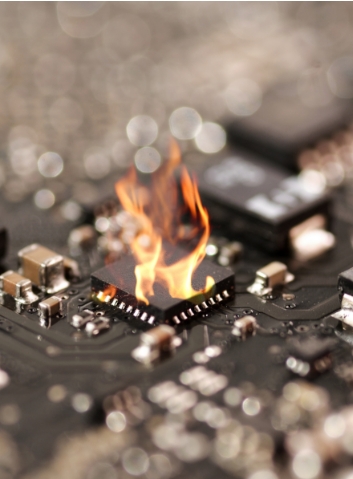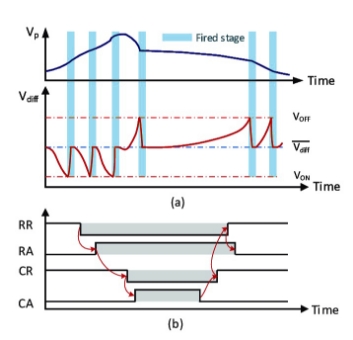The printed circuit board, or PCB, represents the very core of any electronic circuit, it is responsible for the electrical connection between the components and the interfacing of the device with the outside world, so any design error can cause delays, increase costs, or even lead to a malfunction of the product.
In this paper we describe common mistakes that we have encountered.
The BJT (bipolar junction transistor) is a three-terminal component with a base, collector, and emitter. When a voltage is applied between the base and emitter, current flows into the base, which then controls the flow of current between the collector and emitter. The amount of current that flows into the base is proportional to the voltage applied and the resistance of the circuit.
If the base-emitter voltage is too high, excessive current can flow into the base, causing the transistor to overheat and potentially lead to its destruction. To prevent this, a resistor should be placed in series with the base, limiting the current that flows into the transistor and preventing damage.
Additionally, connecting the base to a voltage source through a resistor allows for more precise control of the transistor’s operation. By adjusting the resistance of the base resistor, the amount of current flowing into the base can be finely tuned, allowing for more precise control of the collector-emitter current.
Connecting a resistor in series with the collector or emitter of a BJT is also a common practice in board design. The purpose of this resistor is to limit the current flowing through the transistor and protect it from damage due to overcurrent.
The BJT is a current-controlled device, where the collector current is proportional to the base current. However, the collector current can become very large, especially when the transistor is used in a high-power application. Without a limiting resistor in the collector or emitter circuit, the high collector current can cause the transistor to overheat and possibly fail.
By adding a resistor in series with the collector or emitter circuit, the current flowing through the transistor can be limited to a safe level.
It is necessary to connect the gate pin of a MOSFET to an output pin as it allows the microcontroller or other digital logic to control the MOSFET’s on/off state. The voltage applied to the Gate determines whether the MOSFET is conducting or not, so by connecting it to an output pin, the microcontroller can set the voltage to turn the MOSFET on or off. This enables the microcontroller to control the circuit’s current flow of current in a circuit, making it an important part of many electronic designs.
Neglecting to connect the gate pin is a common mistake which may lead to an always-off MOSFET and a non-functional design.
It is necessary to pay close attention to the transistor TYPE, for example, in an N-channel MOSFET the designer must drive the drain pin of a N-channel MOSFET in order to control the current flow of current through a load, However, for a P-channel MOSFET, the source must be driven to achieve the same effect.
There is often confusion regarding the used transistor type, leading to such mistakes.
It is important to restrict the resistance between power and ground in electronic design to prevent voltage drops and ensure proper circuit operation.
Voltage drops can occur when current flows through resistance, and if the resistance between power and ground is too low, it can cause a significant drop in voltage, which can affect the performance of the circuit.
between power and ground is too low, it can cause a significant drop in voltage, which can affect the performance of the circuit. Additionally, lower resistance can cause current increase, which can lead to heat generation and potential damage to components. Therefore, it is important to restrict the resistance between power and ground.
These types of issues usually arise when designers accidentally connect a small resistor between a power net and a ground net. To find such an error, a PCB designer must go over the schematics, net by net, and make sure there isn’t a single power net connected to ground via a small resistor.

It is important to add a discharge resistor between gate and source in a P-channel MOSFETs to prevent the MOSFET from staying in an always “on” state when the input signal is removed. P-channel MOSFETs operate in the opposite manner to N-channel MOSFETs, where a positive voltage applied to the gate relative to the source turns the MOSFET off. When the input signal is removed, the gate can retain a charge that keeps the MOSFET in an “on” state, leading to excessive power consumption, overheating, or even damage to the MOSFET. By adding a discharge resistor between the gate and source, the capacitor formed by the gate-source capacitance can discharge, ensuring that the MOSFET turns off completely when the input signal is removed. This helps to ensure reliable and safe operation of the MOSFET in the circuit.
Decoupling capacitors reduce electrical noise and voltage fluctuations. Decoupling capacitors are placed in parallel with power and ground pins of integrated circuits to absorb high-frequency noise and smooth out voltage fluctuations caused by current surges in the circuit. These fluctuations can affect the performance of the circuit and lead to errors, glitches, or even damage to components. Decoupling capacitors can also help to mitigate the effects of inductance in the power supply traces, which can cause voltage spikes when the current changes. By adding decoupling capacitors, the voltage at the IC’s power and ground pins is stabilized, ensuring reliable operation, and minimizing the risk of malfunctions or failures.
Moreover, the type and value of the decoupling capacitor have great significance. A ceramic capacitor with a small value will be better for high frequency noise, while a large Electrolytic capacitor will be best for low frequency noise.
Since decoupling capacitors are required quite often, the designer must carefully check the decoupling requirement from the datasheet for each relevant pin and ensure they comply with the component manufacturers’ instructions.
Overvoltage is a situation where the voltage applied to a capacitor exceeds its maximum rated voltage. This can lead to a breach in the capacitor due to the breakdown of the dielectric material or an increase in the equivalent series resistance (ESR), which can cause a reduction in the capacitor’s reliability or even lead to a complete failure. Derating capacitors is essential to ensure their reliable operation and prevent premature failure. Derating involves selecting a capacitor with a voltage rating that exceeds the actual operating voltage by a certain margin, typically around 20-50% over the actual operating voltage. This helps to protect capacitors from various environmental factors such as temperature, humidity, and voltage stress, which can cause a decrease in capacitance or an increase in ESR. By derating capacitors, they can withstand the anticipated operating conditions and provide reliable performance over their intended lifespan
Operating an IC outside of its recommended voltage range, can cause the IC to malfunction. Here are some of the risks associated with operating an IC outside of its recommended voltage range:

To summarize, operating an IC outside of its recommended voltage range can have serious consequences, including damage to the IC, overheating, reduced performance, and reduced lifespan. It is crucial to follow the manufacturer’s recommendations and operate the IC within its specified voltage range to ensure proper functioning and avoid any potential damage or failure
A MOSFET (metal-oxide-semiconductor field-effect transistor) is a type of transistor that works by using an electric field to control the flow of current. MOSFET has three terminals: gate, source, and drain. The gate terminal is insulated from the other two terminals by a thin layer of oxide. When a voltage is applied to the gate terminal, it creates an electric field that attracts or repels charge carriers (electrons or holes) in the channel between the source and drain terminals.
MOSFETs have a parameter called Vgsth (the threshold voltage) which details the minimum voltage required between the gate and source terminals to turn the MOSFET to an “on” state. It is important that
since it ensures that the MOSFET is in an “on” state (in the saturation region) and can conduct the maximum amount of current.
If the voltage between the gate and source terminals is less than Vgsth, the MOSFET will be in the linear region and will not be fully turned on, which can lead to increased power consumption and reduced efficiency. Therefore, it is essential to ensure that the MOSFET is properly biased to achieve optimal performance.
Ambient temperature refers to the temperature of the surrounding environment. The temperature range is selected according to the system’s demands. For example, in automotive regulations, the temperature range is -40 to 150 C for grade 0 and -40 to 125 C for grade 1. The ambient temperature can impact the performance, reliability, and lifespan of all components by affecting the electrical properties and physical processes. It’s important to operate ICs within their specified temperature range.
When electrical components are operated outside their specified ambient temperature range, several things can happen. This is true of all components.
These include:
It is a common mistake to choose a component that does not fit to the operation temperature of the circuit and as explained it is essential to operate electrical ICs within their specified temperature range to ensure reliable performance and prevent damage to the components.
Ensuring compatibility between components is essential for reliable operation of electronic circuits. Various components may have different voltage levels that correspond to logical values, and failure to verify their compatibility can lead to incorrect interpretation of logical values, resulting in circuit malfunction due to undefined behavior.
For instance, if IC A sets logic high as anything above 3V, whereas IC B considers anything above 1.8V as logic high, it can lead to misinterpretation of logical values, causing the circuit to generate incorrect results or fail to perform its intended task.
To ensure reliable and correct operation of electronic circuits, it is crucial to verify the compatibility of the logic levels of the components. This can be achieved by checking the datasheets of the components and verifying that the voltage levels corresponding to the logical values are within the acceptable range of each component.
As an engineer, it is your responsibility to ensure that our circuits operate reliably and correctly, and verifying the compatibility of the components’ logic levels is an essential step towards achieving that goal.
One of the most important parts of the design process is the review – which allows the designer to make sure that the design conforms to the demands of the project. Advance detection of design errors saves both time and effort for the organization and the designer.